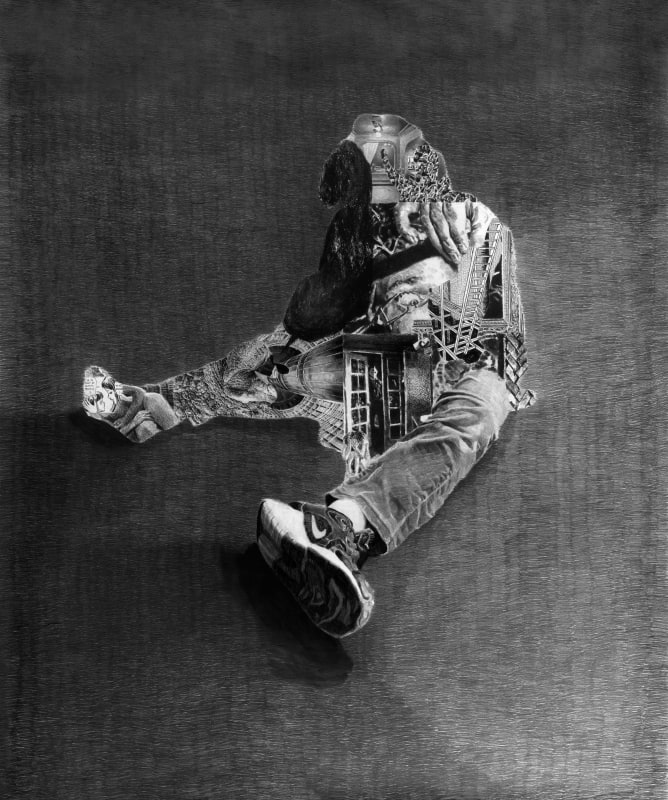Galerie Nathalie Obadia is pleased to present Jérôme Zonder's fifth solo exhibition titled SANS ISSUE (étude pour un portrait de Pierre-François), at the gallery, rue du Cloître Saint-Merri, in Paris. This new body of work brings together the latest portraits of Pierre-François, a figure that has been omnipresent in the artist's graphic universe for over ten years. The recent drawings inscribe themselves in the continuity of his research around a figure borrowed from Marcel Carné's film Les Enfants du Paradis (1945). Jérôme Zonder builds his characters by assembling drawings that are extremely diverse in both subject and stylistic device. The sheer jumble of images at the heart of a single portrait triggers creative collisions - made of visual disharmony and echoes - and invites the viewer to penetrate the very core of a figure that represents the human condition in the Anthropocene era.
For the last twenty years, Jérôme Zonder has developed an oeuvre focused on the constantly reinvented practice of drawing. Portrait occupies a central place: Garance, Baptiste and Pierre-François, three figures of actors inspired by the cinematographic work of Marcel Carné, appear as leitmotivs in his graphic universe. To make his portraits, the artist strives to find the right line, that which, true to its subject, can incarnate it beyond simple figurativeness. To do this, he employs a prolific graphic repertoire: realism, abstract compositions, fingerprinting and codes borrowed from comic strips all come together at the heart of the drawn surface. Add to this effervescence of styles a visual vocabulary that is unique to the artist. Eclectic themes - almost dystopian at times - intertwine and allow the figure's personal story to meld with the great common History: extracts from movies, historic archives and iconic paintings penetrate his subjects and dwell inside his drawings.
Indeed, Jérôme Zonder's figures are evolving entities: the mental landscape of each portrait, sensitive to disruption, inevitably undergoes metamorphoses. It is as though time itself were able to slip into the drawings and alter the figures. The barrier between the real world and fiction becomes porous: the short strokes in the background, exerted by the pressure of the hand onto the surface of the drawing, suggest the rapid pace of the artist's gesture. A palpable frenzy, attesting to the circulations that exist between the different interconnected supports. This tactility establishes direct contact between the artist's human cells and the drawing's carbon paper. Even though it incarnates the historic memory, the application of subtly nuanced black and white also suggests the figure's gray matter, carbon being one of the main molecular components of the human body.
Jérôme Zonder does not reduce his figures to a compilation of lines: the artist deconstructs each portrait so as to seize its depth, its interior workings, its spiritual life. The drawings of Pierre-François bear witness to these permanent back- and-forths between reality and fiction: the character borrowed from Marcel Carné's film Les Enfants du Paradis (1945) noticeably echoes Robert Crumb's publication SANS ISSUE (2004). Similarly to an anthology illustrating the decline of contemporary society, the last portraits of Pierre-François present a weakened person, as though he were sinking under the weight of the drawings. Anchored in a world saturated by information, the human being, slumped in front of screens, consumes an inordinate amount of images to the point that, as Robert Crumb said in 1999, "the TV swallows him, then spits him out, and there isn't much left."1 These excesses of instantaneous consumption provoke a slackening of the body - and intrinsically of the spirit - leading the person toward the ground, into a humus that is ready to collect him. In the artist's last drawings, the head and shoulders of the figure meld into each other to form an organic heap. Thus, by transforming Pierre-François into a pitiful and apathetic character, the artist probes the limits of our 21st-century existences.
In his gestural cinema, Jérôme Zonder manages to assemble many years' worth of feelings and images, work that "rests on a very important process of sedimentation," as the artist indicates. In this vast universe where image proliferates, he succeeds in revealing what Baudelaire called the immense palimpsest of memory: "Layers upon layers of ideas, images, sentiments fell successively on your brain, as gently as the light. Each appeared to bury the one before. But in reality none perished."2 The tangle of multiple feelings and emotions, the perception of one image behind another are fundamental sources of the modernity from which we come. Jérôme Zonder's works are held up like mirrors to our own humanity, allowing the visitor to wander inside and outside of himself, through the mysteries of an extremely vivid polygraphic system.
1 Translated from French: "le poste (TV) l'avale, puis il le recrache, sans qu'il en reste grand-chose" Robert Crumb, SANS ISSUE, Postface by R. Crumb, comments collected by Jean-Pierre Mercier, August 1999, Cornelius Eds, 2004, p.85
2 Translated from French: "Des couches innombrables d'idées, d'images, de sentiments sont tombées successivement sur votre cerveau, aussi doucement que la lumière. Il a semblé que chacune ensevelissait la précédente. Mais aucune en réalité n'a péri." Charles Baudelaire, Les Paradis Artificiels, VIII - Visions of Oxford, Le Palimpseste, JDH Editions, 2021, p.103

